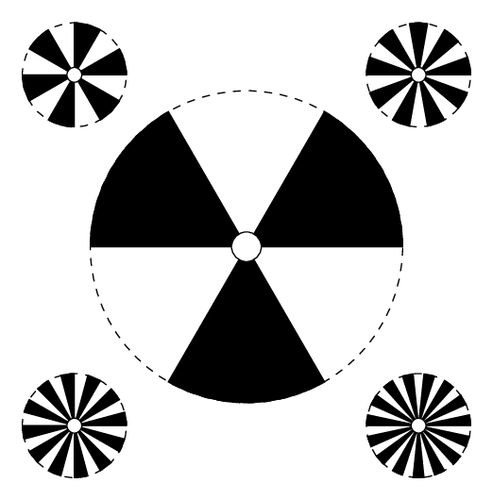This routine draws circles of specified radii that are divided into a definable number of alternating black and white segments. These discs can used to measure the speed of rotation of motors etc. When viewed under a light that is powered by mains electricity the patterns will appear stationary at certain rotation speeds. In Europe these speeds are given by 6000/N rpm - where N is the number of black segments. In the US and other areas that use a 60Hz mains frequency the formula becomes: 7200/N rpm.
You can read about one application of discs of this type at: http://www.jeffree.co.uk/pages/speedmeasurement.html

Edit and compile if you like:
% Routine to draw segmented circles for use as timing strobes
% Author: Simon Martin
\documentclass{article}
\usepackage{tikz}
\usepackage[active,tightpage]{preview}
\PreviewEnvironment{tikzpicture}
\setlength\PreviewBorder{5pt}%
\newcommand{\segments}[3] {% draw circle divided into segments
% #1 = outer radius
% #2 = inner radius
% #3 = no of segments
% note number of segments is total number of black and white segments
% need to pass units with radius.
\def\radius{#1}
\def\nsegs{#3}
\def\segangle{360/\nsegs}
%draw dotted circle as guide for cutting out
\draw [dashed](0,0) circle (\radius);
\foreach \x in {1,3,...,\nsegs} %draw alternate segments
\filldraw[fill=black,draw=black] (0:0mm) -- ({(\x-1)*\segangle}:\radius )
arc ({(\x-1)*\segangle}:\x*\segangle:\radius ) -- cycle;
% draw an inner circle
\draw[fill=white] circle(#2);}
\begin{document}
\begin{tikzpicture}
\matrix [column sep=-5mm, row sep=-5mm] {
\segments{7mm}{1mm}{12} & & \segments{7mm}{1mm}{18} \\
& \segments{21mm}{2mm}{6} & \\
\segments{7mm}{1mm}{24} & & \segments{7mm}{1mm}{30} \\};
\end{tikzpicture}
\end{document}
Click to download: rpm-disc.tex • rpm-disc.pdf
Open in Overleaf: rpm-disc.tex


